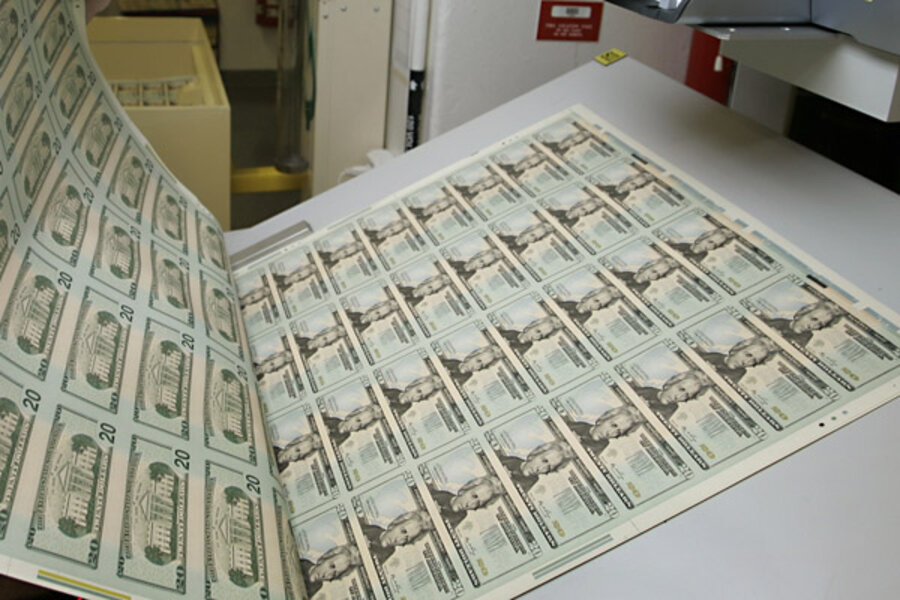Fed prints more money, but consumers won't see it
Loading...
Is the Great Correction still underway? Yes it is! The Wall Street Journal reports:
Consumers continued to cut debt levels in the third quarter, largely as they pulled back from the housing market again, the Federal Reserve Bank of New York reported Monday.
For the most recent quarter, overall debt loads for households fell 0.6% from the prior quarter, for a drop of around $60 billion to $11.66 trillion. The bank said mortgage balances recorded on consumer credit reports fell by 1.3%, or $114 billion, while home equity lines increase by 2.3%. The retreat in mortgage borrowings was the primary driver of the overall drop in consumer borrowing.
Hey, wait. If the central bankers are printing money, why should consumers continue to cut back?
Ah…glad you asked. The central banks are bailing out speculators, bankers, and the feds…not households. The money only reluctantly gets to the consumer level…or not at all.
Instead, the rich get richer…courtesy of a corrupt money system. They get bailed out of their mistakes…and handed a lot of money they don’t deserve.
And the poor? Do they get richer simply because the central banks coddle bondholders? Do the bondholders set up factories and provide middle-skill jobs? Do the speculators invent new industries? Do the insiders set up small businesses and build companies that create new wealth?
Don’t make us laugh, dear reader.
No…the system just becomes more corrupt…and more zombified. Here are the insiders at work…the people the central bankers are trying to help. Bloomberg has the story, from Richard Teitelbaum:
Nov. 29 (Bloomberg) — Treasury Secretary Henry Paulson stepped off the elevator into the Third Avenue offices of hedge fund Eton Park Capital Management LP in Manhattan. It was July 21, 2008, and market fears were mounting. Four months earlier, Bear Stearns Cos. had sold itself for just $10 a share to JPMorgan Chase & Co.
Now, amid tumbling home prices and near-record foreclosures, attention was focused on a new source of contagion: Fannie Mae and Freddie Mac, which together had more than $5 trillion in mortgage-backed securities and other debt outstanding, Bloomberg Markets reports in its January issue.
Paulson had been pushing a plan in Congress to open lines of credit to the two struggling firms and to grant authority for the Treasury Department to buy equity in them. Yet he had told reporters on July 13 that the firms must remain shareholder owned and had testified at a Senate hearing two days later that giving the government new power to intervene made actual intervention improbable…
At the Eton Park meeting, he sent a different message, according to a fund manager who attended. Over sandwiches and pasta salad, he delivered that information to a group of men capable of profiting from any disclosure.
Around the conference room table were a dozen or so hedge-fund managers and other Wall Street executives — at least five of them alumni of Goldman Sachs Group Inc., of which Paulson was chief executive officer and chairman from 1999 to 2006. In addition to Eton Park founder Eric Mindich, they included such boldface names as Lone Pine Capital LLC founder Stephen Mandel, Dinakar Singh of TPG-Axon Capital Management LP and Daniel Och of Och-Ziff Capital Management Group LLC.
After a perfunctory discussion of the market turmoil, the fund manager says, the discussion turned to Fannie Mae and Freddie Mac. Paulson said he had erred by not punishing Bear Stearns shareholders more severely. The secretary, then 62, went on to describe a possible scenario for placing Fannie and Freddie into “conservatorship” — a government seizure designed to allow the firms to continue operations despite heavy losses in the mortgage markets.
Paulson explained that under this scenario, the common stock of the two government-sponsored enterprises, or GSEs, would be effectively wiped out. So too would the various classes of preferred stock, he said.
The fund manager says he was shocked that Paulson would furnish such specific information — to his mind, leaving little doubt that the Treasury Department would carry out the plan. The managers attending the meeting were thus given a choice opportunity to trade on that information…
Yesterday, our colleagues over at The 5-Minute Forecast provided a chilling connection between the former Treasury Secretary’s “insider tip” to his old Goldman buddies and a piece of legislation…
The US Senate is close to passing legislation that would allow the president to use the military to imprison anyone — including US citizens — indefinitely, and without charges. The measure has bipartisan support, sponsored by Republican John McCain and Democrat Carl Levin.
“Combine the recent efforts by John McCain to create a police state with the revelations of Paulson’s corruption (crony capitalism),” writes John Robb at Global Guerrillas, “and you can only conclude that worse is coming.”
Indeed, Robb sees the development of what he calls a “hollow state.”
“The hollow state,” he writes, “has the trappings of a modern nation-state (‘leaders.’ membership in international organizations, regulations, laws and a bureaucracy) but it lacks any of the legitimacy, services and control of its historical counterpart.
“It is merely a shell of a state that serves as a legal conduit and enforcement mechanisms for global financial interests to loot what’s left of the state’s economy. Corruption and violence are its only traits.”
Regards,
Bill Bonner
for The Daily Reckoning





